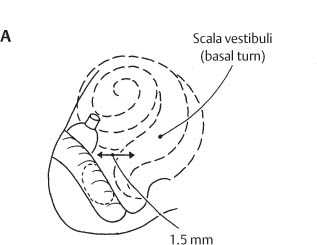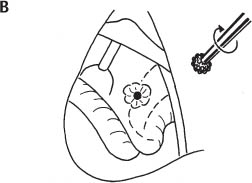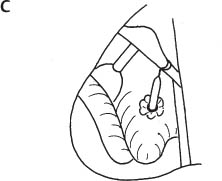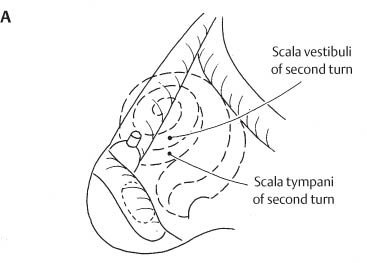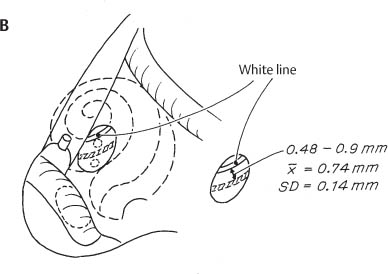Chapter 8 Special Applications of Stapes Surgery Obliterative otosclerosis is found in 13.7% of primary cases (see Results: Stapedecotomy versus 0.6-mm Stapedotomy, p. 278). The first and last steps of the procedure are performed as for stapedotomy (see Figs. 107–109, pp. 225–230, and 116–117, pp. 236, 237).
 Obliterative Otosclerosis
Obliterative Otosclerosis
Surgical Technique
Surgical Highlights |
|
Surgical Steps
Fig. 123A
Surgical site in obliterative otosclerosis
The stapes arch is removed as for stapedectomy. A large promontorial otosclerotic focus obliterates the inferior half of the oval window niche. The remaining stapes footplate is also thickened by otosclerosis. If the space between the facial nerve and stapes arch allows introduction of the 0.6- or 0.8-mm diamond burr, the obliterative focus is drilled away and a stapedotomy opening is created with the stapes arch in place. Otherwise, the stapes arch is removed as in stapedectomy, following separation of the incudostapedial joint using a 1-mm, 90° hook (32-I; Fig. 120E, p. 249).
Fig. 123B
Drilling away the obliterative focus
A 0.8-mm diamond burr is used to remove the excess of promontorial bone saucerizing the oval window niche until a blue area of slightly more than 0.4 mm in diameter is exposed in the center of the oval window. The correct size of the blue area is determined with a malleable 0.4-mm caliper (35-I). Drilling is performed using the Fisch PM microhandpiece (see Handpieces, p. 376), which is slim enough for all types of endaural surgery. Care is taken to avoid irrigation (and therefore contamination) through the EAC. Irrigation is performed by means of a syringe filled with Ringer’s solution fitted with a microsuction tube, which is directly introduced into the middle ear. Drilling and irrigation are not performed simultaneously, but sequentially, because the left hand carries the microsuction tube while drilling.
Fig. 123C
Determination of prosthesis length
The length of the prosthesis is determined with a malleable measuring rod (37-I) after exposure of the blue area in the center of the oval window.
Modifications:If you determine the length of the piston before seeing the blue area, clearly your measure will be too short.
Fig. 123D
Perforation of the oval window
The exposed blue bone is removed with a 0.6-mm diamond burr (see Burrs, p. 377) until the endosteum is exposed. The speed of the burr is reduced for this purpose. Only burrs with a perfect concentric rotation should be used. Eccentric rotation caused by slight distortions in the burr’s shaft does not allow precise work. The last layer of shattered bone covering the 0.4-mm opening is removed with a 0.2-mm footplate elevator (38-I, 39-I). The footplate elevator is bent to conform to the anatomic situation.
Fig. 123E
Introduction and fixation of the TPP
The TPP is trimmed on the cutting block (Figs. 110B, C), introduced with a large smooth alligator forceps (45-I) into the middle ear, and advanced 0.5 mm into the vestibule. The prosthesis loop is attached to the incus with small smooth alligator forceps (44-I).
Modifications: We prefer the use of the titanium stapes piston (TSP), which is handled similarly (see Fig. 119H4, p. 244).
Fig. 123F
Sealing of the stapedotomy opening
Connective-tissue pledgets, venous blood, and fibrin glue are used to seal the stapedotomy opening. Adequate sealing is important in obliterative otosclerosis because the stapedotomy opening is larger than in conventional surgery. With a small hole, the thickness of the surrounding bone could prevent free movements of the prosthesis.
 Floating Footplate
Floating Footplate
A floating footplate may occur after disruption of the stapes arch when a thick otosclerotic footplate is minimally fixed to the annular ligament. Reversal of the conventional steps of stapes surgery with drilling of the footplate with the intact incudostapedial joint and stapes arch has considerably reduced the incidence of a floating footplate. The complication may still occur in biscuit-type otosclerotic foot-plates, which do not permit central perforation before the stapes arch is broken. This occurs in less than 1% of cases.
Modifications:The laser beam is indicated for a floating footplate. We use the Er:YAG laser with impulses of 25–35 mJ. The number of impulses is kept to a minimum to avoid acoustic trauma to the inner ear (8-R).
Surgical Technique
The first and last steps of surgery are performed as for stapedotomy (see Figs. 107–109, pp. 225–230, and 116–117, pp. 236, 237).
Surgical Highlights |
|
Surgical Steps
In the illustrated case, the first steps of the procedure were performed as for stapedotomy. The stapes arch was then removed because there was insufficient space for a 0.6-mm burr between the facial nerve and stapes suprastructure.
Fig. 124A
Attempted extraction with two hooks
One 0.5-mm, 45° hook (left hand) (27-I) stabilizes the posterior crus. A second hook (anterior footplate elevator, 38-I, right hand) is slipped under the inferior margin of the footplate, to try to elevate it out of the oval window. Rotation of the footplate within the vestibule is dangerous. Therefore, the inferior hook should be introduced under the central portion of the footplate to lateralize it without medial rotation of the superior margin into the vestibule.
Fig. 124B
Drilling of a burr hole at the inferior edge of the oval window
If extraction with two hooks is impossible, a small burr hole is drilled along the inferior margin of the oval window using a 0.6-mm diamond burr (Fisch PM microhandpiece, p. 376). The burr hole is just large enough to introduce the tip of a 0.5-mm, 45° hook.
Fig. 124C
Extraction of the floating footplate
The footplate is extracted as described in Fig. 124A. In case of difficult extraction or of inexperience, the surgeon is best advised to do nothing. The operation can then be carried out by a more experienced surgeon after refixation has occurred (6–12 months later).
 Narrow Oval Window Niche
Narrow Oval Window Niche
Surgical Technique
A narrow oval window niche is often the result of a prominent or dehiscent facial nerve covering the majority of the footplate. The first steps of surgery are performed as for stapedotomy (Figs. 107–109, pp. 225–230). The stapes arch is removed as for stapedectomy (Fig. 120E, p. 249).
Surgical Highlights |
|
Fig. 125A
Surgical site following removal of the stapes arch
The facial nerve is dehiscent. The stapes arch obscures the footplate and was removed with crurotomy scissors (54-I, 55-I).
Fig. 125B
Enlargement of the oval window niche
The excess of promontorial bone is removed with a 0.8-mm diamond burr until the inferior half of the footplate is visible.
Fig. 125C
Stapedotomy
A 0.5-mm opening is made with manual perforators (40–43-I) (in a blue footplate) or with a 0.6-mm diamond burr in a white, thickened footplate.
Fig. 125D
Introduction and fixation of the TPP
A 0.4-mm TPP is introduced into the stapedotomy opening. The prosthesis loop is firmly attached to the incus. The stapedotomy hole is sealed with connective tissue, venous blood, and fibrin glue.
Modifications: We now use a 0.4-mm TSP.
Fig. 125E
Subtotal obstruction of the oval window by a dehiscent facial nerve
In the presence of a very prominent and dehiscent facial nerve, the incus is removed because the mobility of the prosthesis would be hampered. The 0.5-mm opening is partially made under the nerve with manual perforators. This is a situation in which the use of a laser is too dangerous for the facial nerve and where a mechanical solution (perforators) is preferred!
Fig. 125F
Malleo-stapedotomy
The 0.4-mm TPP is attached to the malleus handle and advanced into the vestibule. The mobility of the Teflon piston remains free due to the anterior inclination of the prosthesis. The stapedotomy opening is larger than usual to account for the angulation of the piston.
Modifications: In this situation we now use an angled titanium stapes prosthesis (see Fig. 119L2). For perfect results the prosthesis shaft should reach the footplate perpendicularly. Maximal correction of the oblique position (bending of the shaft) avoids limitations in prosthesis movement due to contact with the edges of the stapedotomy.
 Short Incus
Short Incus
A short incus creates the problem of possible contact between the prosthesis and facial nerve.
Surgical Technique
The first and last steps of the procedure are performed as for stapedotomy (see Figs. 107–109, pp. 225–230, and 116–117, pp. 236–237).
Surgical Highlights |
|
Surgical Steps
Fig. 126A
Surgical site with short incus
The 0.5-mm stapedotomy was performed after removal of the stapes arch.
Fig. 126B
Stapedotomy with modified prosthesis
The platinum shaft of the 0.4-mm TPP has been bent in situ between two hooks to overcome the bulge of the dehiscent facial nerve. Modification of the prosthesis is technically more difficult and the results are not as good as those of malleo-stapedotomy (see next figure).
Modifications: We now use a 0.4-mm TSP for the procedure.
Fig. 126C
Malleo-stapedotomy
The anteroinferior angulation of the prosthesis avoids contact between the piston and facial nerve. The functional results of malleo-stapedotomy are comparable to those of stapedotomy (see p. 284).
Modifications:We presently use a TSP with the angulation in the figure.
 Anomalous Facial Nerve
Anomalous Facial Nerve
An anomalous facial nerve is often a surprise during surgery performed for conductive deafness because the auricle, external canal, and tympanic membrane are often normal in appearance. A facial nerve lying over the oval window niche may be associated with an anomaly of the long process of the incus and of the stapes arch. The alternatives for functional restoration of hearing in this situation are: (1) the displacement of the facial nerve with vestibulotomy and (2) the acterior promontorial cochleostomy.
Preoperative HRCT scans (see Part 4) greatly contribute in clarifying difficult anatomical situations and their systematic use helps, therefore, in obtaining better postoperative results.
 Vestibulotomy
Vestibulotomy
This operation is performed only if the blue area of the vestibule is visible through the bone after minimal superior displacement of the anomalous tympanic facial nerve. Wide displacement of the facial nerve may be too dangerous, and the operation is not performed under these circumstances.
Surgical Technique
The first and last steps of surgery are performed as for stapedotomy (see Figs. 107–109, pp. 225–230, and 116–117, pp. 236, 237).
Surgical Highlights |
|
Surgical Steps
Fig. 127A
Surgical site with anomalous facial nerve covering the oval window
The long process of the incus and stapes arch is malformed. No oval window is visible.
Fig. 127B
Identification of the blue area of the vestibule
The facial nerve is gently elevated with the Fisch microraspatory (23-I, 24-I) for a fraction of a millimeter, exposing the bluish area of the vestibule.
Fig. 127C
Vestibulotomy
A 0.8-mm diamond burr is used to remove the bone covering the inferior edge of the blue vestibular area. A 0.5-mm opening is created with a 0.6-mm diamond burr in the exposed blue area, close to the facial nerve.
Fig. 127D
Malleo-stapedotomy
A 0.4-mm TPP is attached to the malleus handle and introduced into the vestibule. Sealing of the oval window, repositioning of the tympanomeatal flap, packing, and wound closure are performed as for stapedotomy.
Modifications: We now use a TSP because titanium has the ideal combination of flexibility and rigidity to accept all kinds of angulations (see Fig. 119L2).
Fig. 127E
Incorrect placement of the prosthesis
Revision surgery showed that an anomalous facial nerve may be interpreted by an inexperienced surgeon as a “polyp” covering the oval window! A Shea Teflon piston introduced through the polyp in the vestibule caused immediate facial palsy and total loss of hearing! The piston was removed at revision surgery and the facial nerve widely decompressed to permit recovery of facial function.
 Promontorial Cochleostomy
Promontorial Cochleostomy
A promontorial cochleostomy is performed if exposure of the expected vestibule requires wide displacement of the anomalous facial nerve. The surgical steps for promontorial cochleostomy are shown in the following section (see pp. 265, 266).
 Missing Stapes
Missing Stapes
Congenital absence of the stapes is characterized by a total conductive hearing loss. Two anatomic situations are possible: (1) the facial nerve is in the normal position and the oval window identifiable; or (2) the abnormal stapes is associated with an anomalous facial nerve, and the oval window niche is not identifiable. High-resolution computed tomography (HRCT) scans are required to exclude an accompanying inner ear malformation that may lead to a possible gusher or make functional surgery impossible (see Chapter 11, p. 349).
 Identifiable Oval Window Niche
Identifiable Oval Window Niche
Surgical Technique
The operation is carried out with local anesthesia or general anesthesia. The first and last steps of the procedure are performed as for stapedotomy (see Figs. 107–109, pp. 225–230, and 116–117, pp. 236, 237).
Surgical Highlights |
|
Surgical Steps
Fig. 128A
Anomalous stapes with an identifiable oval window
The facial nerve in its normal position. The malformed incus was removed. The stapes footplate is missing; the oval window niche is well defined by a depression and bluish discoloration of bone.
Fig. 128B
Perforation of bone in the center of the oval window niche
A small opening is made in the center of the oval window niche with manual perforators (40–43-I) or with a 0.6-mm diamond burr. If a gusher is excluded, stapedotomy is performed.
Fig. 128C
Stapedotomy
The opening in the center of the oval window is enlarged to a diameter of 0.5 mm.
Fig. 128D
Stapedotomy (cont.)
A 0.4-mm TPP is introduced into the vestibule and attached to the incus. The further surgical steps are the same as for stapedotomy (see p. 232).
Fig. 128E
Gusher
An extensive outflow of perilymph occurs through the small perforation made in the center of the oval window niche. If the patient has accepted the risks involved with stapedotomy, lumbar drainage is applied.
Fig. 128F
Gusher (cont.)
The lumbar drainage has stopped the perilymph flow through the stapedotomy opening. The stapedotomy opening is enlarged with manual perforators, and a 0.4-mm TPP is introduced into the vestibule and attached to the incus.
Fig. 128G
Gusher (cont.)
Three pieces of connective tissue from the endaural incision are wrapped around the stapedotomy opening. The connective tissue pieces are large enough to be kept in place by the long process of the incus. Cubital venous blood and fibrin glue are used to supplement the sealing. The intralumbar drain is maintained for 4–5 days.
Fig. 128H
Gusher (cont.)
The patient does not agree to accept the risks involved with a stapedotomy procedure. The operation will be discontinued.
Fig. 128I
Gusher (cont.)
The operation is discontinued because the patient has not agreed to accept the risks involved with stapedotomy. The small perforation in the center of the oval window niche is closed with a piece of connective tissue large enough to be firmly secured between the oval window and the incus. Cubital venous blood and fibrin glue supplement the sealing. The patient will be provided with a hearing aid.
 Unidentifiable Oval Window Niche
Unidentifiable Oval Window Niche
Surgical Technique
Two alternative techniques are presented:
a Indirectly guided cochleostomy.
b Directly guided cochleostomy.
The risk of total deafness in cochleostomy is significantly higher than in stapedotomy. The operation should be carried out by very experienced surgeons. Mobilization of the anomalous facial nerve with vestibulotomy is a further possibility to be discussed with the patient if the anatomic conditions are unfavorable for cochleostomy.
a) Indirectly Guided Cochleostomy
If the oval window is unidentifiable, fenestration of the scala vestibuli in the basal turn of the cochlea has been advised by Plester (Plester et al. 1989). The landmarks for the 1-mm diameter cochleostomy are given as 1 mm anterior and 1.5 mm inferior to the anterior border of the oval window. These landmarks are difficult to define when the oval window is missing. For this reason we have modified Plester’s measurements using the cochleariform process as a reference.
Surgical Highlights |
|
Fig. 129A
Landmarks for indirect cochleostomy
The upper portion of the scala vestibuli of the basal turn is found 1.5 mm below the posterior edge of the cochleariform process.
Fig. 129B
Cochleostomy in the scala vestibuli of basal turn
The malformed incus and stapes arch were removed. A 0.8-mm diamond burr with suction-irrigation is used to drill the cochleostomy in the scala vestibuli of the basal turn.
Fig. 129C
Malleo-stapedotomy
A 0.4-mm TPP has been trimmed to the proper length, attached to the malleus handle, and introduced into the scala tympani of the basal turn. The piston protrudes 0.2 mm. If there are doubts about the perfect localization of the cochleostomy, the endosteum is not opened and the piston just placed over it.
Modifications: We now use a TSP. The angulation of the shaft must be carefully performed to achieve a perpendicular plane to the cochleostomy.
b) Directly Guided Cochleostomy
Drilling a cochleostomy on the basis of coordinates only carries a significant risk of sensorineural deafness. For this reason, Dr. J. Buckley1 performed a temporal bone study in our laboratory to determine a more reliable method for cochleostomy. The technique has been used in a limited number of patients and awaits further confirmation of results. To date, however, no hearing loss has been observed after directly guided cochleostomy of the scala tympani or vestibuli of the middle turn.
1 Janet Nash Clinical Fellow, 1993
Fig. 130A
Schematic view of cochlear turns
The second turn of the cochlea begins below the anterior part of the cochleariform process and forms an angle of approximately 45° to the semicanal of the tensor tympani muscle.
Fig. 130B
Stay updated, free articles. Join our Telegram channel

Full access? Get Clinical Tree


 Local or general anesthesia.
Local or general anesthesia. Endaural incision.
Endaural incision. Elevation of tympanomeatal flap.
Elevation of tympanomeatal flap. Assessment of mobility of malleus.
Assessment of mobility of malleus. Exposure of oval window.
Exposure of oval window. Removal of stapes arch.
Removal of stapes arch. Removal of obliterative focus with diamond burr.
Removal of obliterative focus with diamond burr. Exposure of a blue area in central oval window.
Exposure of a blue area in central oval window. Determination of prosthesis length and trimming.
Determination of prosthesis length and trimming. Formation of a stapedotomy opening.
Formation of a stapedotomy opening. Introduction and fixation of prosthesis.
Introduction and fixation of prosthesis. Sealing of stapedotomy opening with connective tissue, venous blood, and fibrin glue.
Sealing of stapedotomy opening with connective tissue, venous blood, and fibrin glue.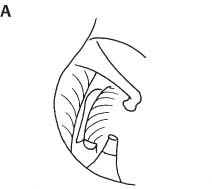
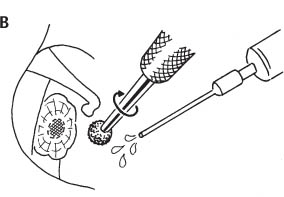
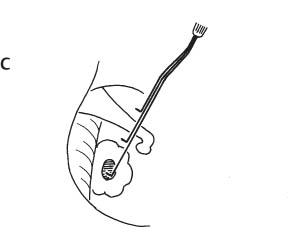

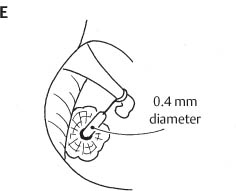
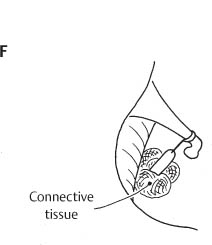
 Drilling a small opening at inferior margin of oval window niche with a 0.6-mm diamond burr.
Drilling a small opening at inferior margin of oval window niche with a 0.6-mm diamond burr. Extraction of footplate through inferior burr hole with a hook.
Extraction of footplate through inferior burr hole with a hook.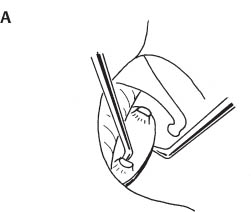
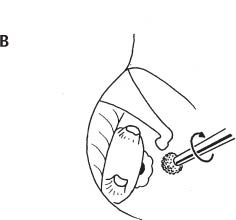
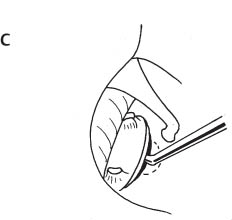
 Enlargement of oval window niche with diamond burr.
Enlargement of oval window niche with diamond burr. Incus-stapedotomy (IS) or malleo-stapedotomy (MS).
Incus-stapedotomy (IS) or malleo-stapedotomy (MS).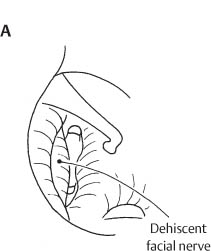
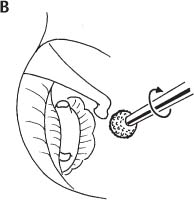
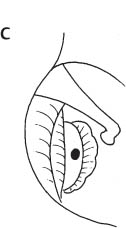
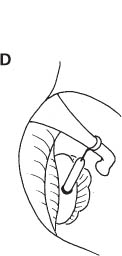
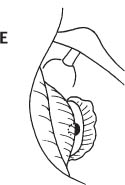
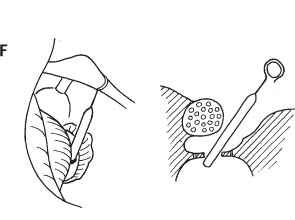
 Incus-stapedotomy with bending of shaft of prosthesis to overcome the bulge of facial nerve or
Incus-stapedotomy with bending of shaft of prosthesis to overcome the bulge of facial nerve or Removal of the incus and malleo-stapedotomy.
Removal of the incus and malleo-stapedotomy.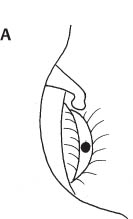
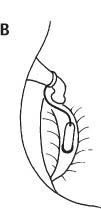
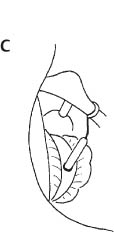
 Removal of malformed incus and stapes arch.
Removal of malformed incus and stapes arch. Minimal superior displacement of anomalous facial nerve.
Minimal superior displacement of anomalous facial nerve. Identification of blue area of vestibule.
Identification of blue area of vestibule. Burr hole in center of expected oval window.
Burr hole in center of expected oval window. Malleo-stapedotomy.
Malleo-stapedotomy.
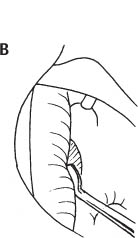
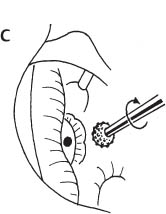
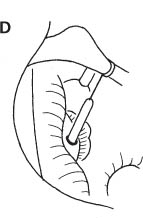
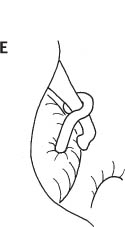
 Minimal perforation in center of oval window niche to exclude a gusher.
Minimal perforation in center of oval window niche to exclude a gusher. If no gusher: stapedotomy.
If no gusher: stapedotomy. In the presence of a gusher: (a) intra-lumbar drain and stapedotomy or (b) if the patient refuses to accept the risk of total deafness (which is higher than in stapedotomy) the hole made in the footplate is closed and a hearing aid is advised.
In the presence of a gusher: (a) intra-lumbar drain and stapedotomy or (b) if the patient refuses to accept the risk of total deafness (which is higher than in stapedotomy) the hole made in the footplate is closed and a hearing aid is advised.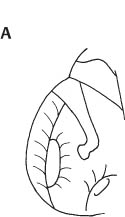
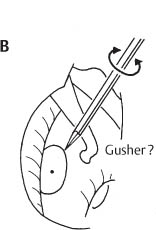
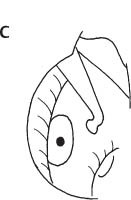
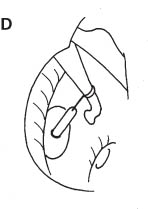
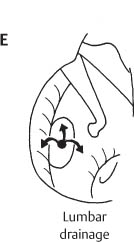
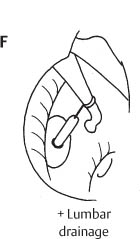

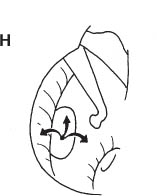
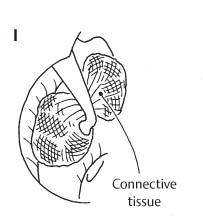
 Identification of cochleariform process.
Identification of cochleariform process. Cochleostomy performed in scala vestibuli of basal turn 1.5 mm below posterior edge of cochleariform process.
Cochleostomy performed in scala vestibuli of basal turn 1.5 mm below posterior edge of cochleariform process. Malleo-stapedotomy.
Malleo-stapedotomy.